March 2, 2007
Air Date: March 2, 2007
FULL SHOW
SEGMENTS
Texas Turnaround
/ Jeff YoungView the page for this story
Texas power giant TXU was on a fast track to build eleven new coal-fired plants. Now an investment group is poised to take over the utility and, after negotiating with environmental groups, is canceling all but three of the coal plants. Living on Earth's Jeff Young looks at how the deal went down. (06:00)
Coal Going Green, For More Green?
View the page for this story
Host Steve Curwood speaks with environmental economist Billy Pizer, a senior fellow with Resources for the Future, to discuss the investment value of TXU, and what the TXU buyout could mean for the future of coal production and greenhouse gas emissions reductions around the country. (06:00)
Bees On Their Knees
View the page for this story
A mysterious ailment is killing the nation's honeybees, and it’s spreading over nearly half the United States. Steve Curwood talks with Jerry Hayes, chief of the Apiary Section of Florida's Department of Agriculture. (06:30)
Western Carbon Club
/ Amy StandenView the page for this story
Five western states, from Washington to New Mexico, have banded together to coordinate their carbon reductions efforts to address global warming. These states, plus Northeast and Atlantic states with similar pledges, are forming the basis of a de-facto carbon trading market, a course opposed by the Bush administration. KQED’s Amy Standen reports. (03:00)
Step It Up 2007
View the page for this story
Author and environmentalist Bill McKibben and a small team of recent college graduates have launched a grassroots movement via cyberspace to combat climate change. They’re organizing a nationwide day of rallies on April 14th to urge Congress to reduce greenhouse gas emissions 80 percent by 2050. Host Steve Curwood talks with McKibben and his web director, Jon Warnow, about their call for climate action. (07:00)
Emerging Science Note/Beaver in the Bronx
View the page for this story
The beaver is back in New York City after a 200 year absence. Meghan Vigeant reports. (01:30)
Old Mill Gets Green Makeover
/ Bruce GellermanView the page for this story
An historic, but rundown, mill in Lawrence, Massachusetts is being transformed into the nation's largest green redevelopment project. The famous Wood Mill, once the largest textile mill in the world, will be converted into condominiums that use geothermal heat. Living on Earth’s Bruce Gellerman reports on the mill, and on Lawrence, past, present and future. (15:00)
This week's EarthEar selection
listen /
download
It's playtime in this winter wonderland in Belmont, MA.
Show Credits and Funders
Show Transcript
HOST: Steve Curwood
GUESTS: Billy Pizer, Jerry Hayes, Bill McKibben, Jon Warnow, Bob Ansin, Matt Bovenzi, Patricia Jaysane, Ed Connelly
REPORTERS: Jeff Young, Amy Standen, Bruce Gellerman
SCIENCE NOTE: Meghan Vigeant
[THEME]
CURWOOD: From Public Radio International - this is Living on Earth.
[THEME]
CURWOOD: I’m Steve Curwood.
A proposed multi billion dollar buyout of a major Texas power company is signaling a change in the rules of the game. The bid is based on cutting back on coal-fired power plants that promote global warming.
HAWKINS: This is really about the role of big business in helping to solve the global warming problem.
CURWOOD: Also, scientists are sounding the alarm about the recent mysterious and rapid disappearance of honey bees.
HAYES: If you don’t have honeybees, about a third of the food you and I eat every day would disappear. And Albert Einstein, a guy a lot smarter than you and I, said that if honeybees became extinct, human society would follow in four years. We’re all connected here, and so one of my questions is, are honeybees the canaries in the coal mine?
CURWOOD: These stories plus, wild beavers are back in New York City this week on Living on Earth. Stick around!
ANNOUNCER: Support for Living on Earth comes from the National Science Foundation and Stonyfield Farm.
Texas Turnaround

TXU is dropping plans to build eight more plants like this one, its Monticello Steam Electric Station, named after nearby Lake Monticello, Texas. (Courtesy of TXU Corp.)
CURWOOD: From the Jennifer and Ted Stanley Studios in Somerville, Massachusetts - this is Living on Earth. I’m Steve Curwood. As investment firms hoping to take over a Texas power company were refining their bid last month, they asked for help from an unusual source: environmental groups. Outfits like Environmental Defense and others had been fighting the power company, TXU, over its plans to build nearly a dozen new coal-fired power plants. The private equity firms Texas Pacific and KKR wanted to know what it would take to get green groups to support the takeover bid. The result of the talks is a 32-billion-dollar proposed cash buyout of TXU that could bring a dramatic reduction in the growth of the firm’s greenhouse gas emissions.
The deal isn’t yet final. Still, as Living on Earth’s Jeff Young reports, when environmental groups are at the table for what could become the biggest corporate buyout in U.S. history, you know something very different is going on.
YOUNG: TXU executives were so sure their new power plants would be built they’d already signed contracts for boilers to burn the coal. And why not? After all, the Texas governor himself had put permits for TXU’s 11 coal-fired facilities on a fast track to approval. But that fast track quickly derailed. Now, private equity firms are gobbling up TXU, teaming up with environmentalists and knocking down plans for all but three of those coal-fired plants.

TXU is dropping plans to build eight more plants like this one, its Monticello Steam Electric Station, named after nearby Lake Monticello, Texas. (Courtesy of TXU Corp.)
HADDEN: We’re very concerned that what’s happening here in Texas could undo the gains made elsewhere in the country. We don’t want that to happen and we’re fighting hard.
YOUNG: Soon it wasn’t just environmentalists speaking up. The mayors of Dallas and Houston, the Waco Chamber of Commerce, ranchers and republican lawmakers all had concerns about coal power. Republican state representative Charles "Doc" Anderson wrote a bill to slow down TXU’s permits.
ANDERSON: Haste makes waste. Let’s do it right, let’s not rush things. Let’s look out for the health of our people and ah, and ah, Texas can lead the nation.
YOUNG: By January Anderson’s proposed moratorium on coal was gaining strength, despite a small army of TXU lobbyists in the statehouse. Then two leaders in the U.S. Senate weighed in. Democrats Jeff Bingaman and Barbara Boxer chair the Senate energy and environment committees, respectively and both want a law to cut the country’s greenhouse gas emissions. They wrote an opinion piece in a Dallas newspaper putting TXU’s potential investors on notice.
BINGAMAN: It made a point that needed to be made about TXU not being able to assume that future coal fired plants would be grandfathered in if we’re able to adopt a cap and trade system. I think that’s a point that needed to be made so we were glad to make it.
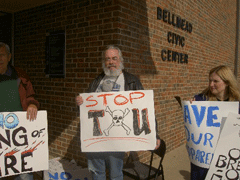
Did these TXU protesters pave the way for the biggest buyout in history? (Photo: Jeff Young)
HAWKINS: This is really about the role of big business in helping to solve the global warming problem.
YOUNG: That’s David Hawkins of the Natural Resources Defense Council. The money managers planning to take over TXU asked NRDC and the group Environmental Defense to join a secret week of negotiations to give the deal a green stamp of approval. The result is a pledge to turn a company that would have been one of the country’s biggest sources of greenhouse gases into one that will dramatically cut emissions. The new TXU would meet much of its energy demand through efficiency and wind energy. It would tie executive pay to environmental performance. And it will join a business team lobbying Congress for a law to control global warming pollution. That deal still has to win approval from Texas lawmakers worried about ratepayer costs. And other investors might yet make rival bids. But if finalized, the buyout would bring a remarkable turnaround, made more noteworthy by the players involved.
REICHER: I think it’s quite a powerful signal being sent by kind of the core of the investment industry.
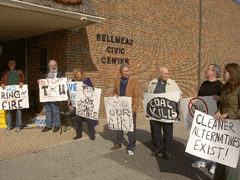
Fired up over coal-fired power. These demonstrators spoke out at a hearing near Waco, Texas. (Photo: Jeff Young)
REICHER: This is the core of Wall Street sitting down and saying we are not gonna place as big a bet as we thought we were on old fashioned coal-fired power plants.
YOUNG: Even some coal-rich states are getting the message. Montana’s Democratic Governor Brian Schweitzer says it’s time for coal companies to start dealing with their greenhouse gases if they want Wall Street to deal with them.
SCHWEITZER: There’s going to have to be some companies that take the lead so that these, ah, new zero emission coal plants will get built and electricity will be delivered to the markets.
YOUNG: Many in the climate science community see the TXU buyout as a positive move. Woods Hole Research Center Director and Harvard Professor John Holdren just helped write a United Nations report called "Confronting Climate Change.”
HOLDREN: We say that the world should no longer build any coal burning power plants that are not amenable to retrofit to capture and sequester their carbon dioxide. None, no more.
YOUNG: Around the country there are still some 150 coal power proposals on the drawing board. Environmental groups, emboldened by the success of the TXU takeover, aim to stop them. So the companies in the coal business can expect to feel some heat.
For Living on Earth I’m Jeff Young in Washington.
Related links:
- TXU comment on the environmental agreement included in the proposed TXU buyout:
- the Natural Resources Defense Council
- Environmental Defense comment on the environmental agreement included in the proposed TXU buyout:
- To listen to Jeff Young's piece "Deep In the Heart of Texas, It's Coal Versus Climate" from our January 5, 2007 show click here
Coal Going Green, For More Green?
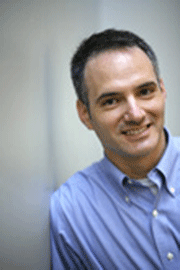
William A. Pizer (Courtesy of Resources for the Future)
CURWOOD: Now, there are still many details to be worked out for the TXU deal. One key question is how compatible the proposed three new coal-fired power plants would be with emerging technologies that could capture their global warming gases. But even having such questions in play indicates a big change in thinking by major investors, including Goldman Sachs, J.P. Morgan and other Wall Street investment banks that are backing up the deal.
For a closer look at this shift in the economic landscape we turn now to Billy Pizer. He’s an environmental economist and senior fellow at Resources for the Future, a think tank in Washington D.C. Hi, there.
PIZER: Hello Steve.
CURWOOD: So walk us through what these two private equity firms are hoping to do by purchasing TXU. Ah, this energy market is a very complicated business.
PIZER: Well, I think they believe that they can rearrange, repackage, manage better in a way that will raise the asset value of the company and that at some point in the future they can sell it and make money. The thinking that they have is that there’s something undervalued there. And that by bringing their expertise they can add value, they can increase the brand value; they can increase the efficiency of the organization. They can do something to change the way the company is run or operated or perceived that raises its value. And that’s what their interest is when they take over a company like this.

William A. Pizer (Courtesy of Resources for the Future)
PIZER: Well that’s a good question. I think that, you know, for KKR and the other funders the real advantage of bringing environmental groups in is the environmental groups give them more stakeholders at the table bringing support for this deal. So it just kinda makes sense that if all these people were cheering against TXU before and you can bring them to the table cheering for the new guys then that’s going to put additional pressure to make the deal go through.
In terms of what the environmentalists get they presumably were able to negotiate better pieces of the deal than they would have gotten if they hadn’t been at the table. So you have money being spent on energy efficiency. You have a commitment to renewables. Whether or not those things were originally on the table when the buyers started crafting the deal is not clear. But certainly the environmentalists, I’m sure, got something out of the deal.
CURWOOD: How much of a sea change in our approach to coal fired power plants does this proposed deal represent? I mean is this some kind of watershed event this proposal?
PIZER: I don’t think it’s a huge watershed. I mean, you know, the bottom line is they’re still building three coal plants and they’re going to do some additional renewables. And they’re going to do some energy efficiency, but in a growing part of the country they’re going to need more power. And a really complicated question is what is that power going to look like, that new base load capacity? And fundamentally there are only three choices: there’s natural gas, there’s coal, and there’s nuclear. Um, you can build renewables but you need to have back-up generation when the wind doesn’t blow. You can do energy efficiency but when you invest in energy efficiency you’re not quite sure what you’re going to get. So there’s going to have to be some more capacity built. And when people look at the spectrum of those three choices a lot of times coal still comes up looking good. And I think what the environmentalists are pushing for is just don’t build more than you need. And try to work as much as you can on the renewables. Try to work as much as you can on the energy efficiency. So it’s not so much a sea change as much as I think it is mounting pressure to think harder about how much coal is going to be built.
CURWOOD: Some of the banks that would lend Texas Specific Group and KKR the money for this are putting some of their own equity into the deal. I mean why are banks willing to take on extra risk in this case?
PIZER: Well, I mean, they have to feel like it’s a good deal. They have to feel like there is a profit opportunity for them there. They clearly are attracted I think to the environmental angle. I think it kind of benefits everyone including the environment. And so I think they’re there because they think that the management team the investors are putting together and the strategy they have for saving money and helping the consumers, helping the environment, and helping the investors is a solid one.
And the other thing is I think there is a sense in which these guys are kind of reading the tea leaves in terms of the directions that policies are going and the direction that we’re moving in the country. And the fact that they’ve kind of recognized this and they’re putting their money into it I think has attracted other people’s money. And, you know, when you see other investors realize that this is the direction, you know there are a lot of people out there trying to make money off of this change that’s going on in the United States. I don’t call it a sea change but you know I call it a gradual change taking place as people look towards more environmentally friendly investments and the people who are quicker on the draw are going to make more money than the people who are slow or are not.
CURWOOD: What’s really the most important thing about this proposed buy out for the climate change debate?
PIZER: I think it highlights where the middle is. I think, on the one hand you have a bunch of companies who may be, kind of living in the past a little bit, thinking a lot about coal as being the way of the future and pulverized coal as being the way we’ve done it before and the way we’re going to do it in the future. On the flip side you have the environmentalists who don’t want to see any new coal built from this day forward. And what this deal I think represents is how the middle is going to work. You’re going to build some coal plants but you’re going to spend money on energy efficiency. You’re going to spend money on renewables. And it’s going to be a package of things that leads to less emissions than we would have had otherwise but it’s still going to require some emissions growth especially for the near term. And I think the really valuable message from this is there is a way forward and there is a way that we can compromise between what the two sides are arguing for. And still end up satisfying our customers and satisfying the environment and satisfying investors.
CURWOOD: Billy Pizer is an environmental economist and senior fellow at Resources for the Future in Washington. Thank you sir.
PIZER: Thank you Steve.
Related links:
- Texas Pacific Group
- TXU Corp
- Kohlberg Kravis Roberts & Co.
CURWOOD: Just ahead honeybees are crucial for pollinating crops, but they’re disappearing. And scientists are racing to solve the mystery. That’s coming up on Living on Earth.
[MUSIC: Kaki King “Kewpie Station” from ‘La Guitara: Gender Bending Strings’ (Vanguard Records - 2005)]
Bees On Their Knees
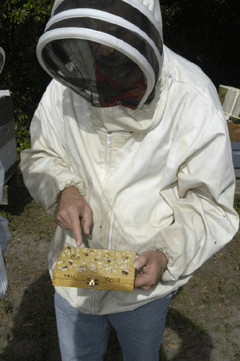
Jerry Hayes counts the number of varroa mites (dark spots visible against white drone bees) on drone brood (young bees) pulled from a colony. (Courtesy of Florida Department of Agriculture and Consumer Services)
CURWOOD: It’s Living on Earth. I’m Steve Curwood. Something mysterious is killing the nation’s honeybees and it’s alarming scientists and beekeepers, who first noticed the strange die-off last year. Now the bizarre syndrome, which researchers have dubbed “Colony Collapse Disorder” has spread to nearly half the states and is responsible for killing as many as 90 percent of the hives in some places.
And there have been similar reports from Europe as well. The rapid die-offs here put more than a third of U.S. food crops in peril because without honeybees, many fruits, vegetables, and nut trees wouldn’t get pollinated. Jerry Hayes is Chief of the Apiary Section at Florida’s Department of Agriculture. We gave him a buzz on his cell phone in a research field outside of Gainesville.
Hi there Jerry—
HAYES: How are you doing Steve?
CURWOOD: Hey uh I think I can hear some bees. Are you wearing your protective hood and uniform now?
HAYES: Yes, if you could see me right now I, ah, have a white jacket on and a veil and there are thousands of bees in the air. Let me walk over here to one of the colonies and maybe you can even hear better.

A honey bee. (Courtesy of USDA)
HAYES: Uh yes. Actually the first reported case to me was late last summer in Florida. And it’s just gotten, ah, more confusing and frustrating as the months have gone by.
CURWOOD: So, the mystery then continues. Um, if you could please, ah, describe the disorder for me. What do the bees look like when they die?
HAYES: Well that’s the problem the bees are leaving the colonies. They’re not coming back. They’re actually disappearing as if the adult workers, the foragers, are going out and not remembering how to get home. So there aren’t any dead bodies as you would see in a pesticide kill or something. The hives basically dwindle over time as bees leave the colony and, ah, don’t return which is very unusual for a social insect like the honeybee because they are very colony oriented. They want to take care of the brood, the queen, so to leave the colony and not come back is highly unusual.

Jerry Hayes counts the number of varroa mites (dark spots visible against white drone bees) on drone brood (young bees) pulled from a colony. (Courtesy of Florida Department of Agriculture and Consumer Services)
HAYES: Yes, and all these are normal organisms that are associated with honeybee colonies. But the honey bee’s immune system seems to be being compromised and allowing these what would be normal organisms in the honey bees to proliferate and may be causing some of the final death stages.
CURWOOD: There’s some suggestions that it could be due to some chemicals that are used on plants. And these chemicals, in fact, have been banned in Europe. What are you finding?
HAYES: Um you know the ultimate answer on that is still out. But yes you’re right Steve there is a class of insecticides called neonicotinoids, of which, ah, an active ingredient called imidacloprid has been banned in some countries in Europe because of its association with damaging, ah, pollinators. It has a tendency to, at least in the European data, to have the bees forget how to get home. And so this is one of the components that we’re seeing here. And these neonicotinoids and imidacloprid is used pervasively in agriculture in the U.S. Primarily it’s a systemic. So it does what it’s supposed to do on harmful agricultural pests but it’s working its way through the plant up into the flowers and getting into the nectar. Ah, in doses that will not kill a honeybee out right. So the question is what are the chronic long-term 24/7 365 exposures doing to the honeybees and is this a component of the problem?
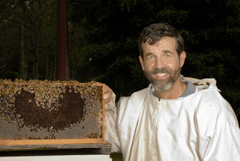
Jerry Hayes examines honey comb for pests and diseases. (Courtesy of Florida Department of Agriculture and Consumer Services)
HAYES: Well, yeah and if you look at the literature this imidacloprid is used on another social insect; the termite. Termites are social insects just like the honey bees and they have a very organized nesting colony. The imidacloprid used in termite colonies causes death by a couple of different means. One of them is that the termites go out to feed and they can’t remember how to get home. And it causes them to be susceptible to, ah, natural organisms in their own nest colony. So if you extrapolate to honey bees, you know, this is kind of a scary thing.
CURWOOD: People eat a modest amount of honey but they seem to be crucial to agriculture. Can you explain?
HAYES: Yes, we think of honey bees as producing honey. And honey is a wonderful food. It comes in great varieties and is wonderful, but it’s a byproduct of pollination. Without honeybees and other pollinators to take pollen from one flower to another flower to fertilize the seed, the plant then has no inclination to build a fruit then around that seed. So if you don’t have honey bees about a third of the food you and I eat every day would disappear. And Albert Einstein, a guy a lot smarter than I am, said that if honey bees became extinct, human society would follow in four years. We’re all connected here. And so one of my questions is, are honeybees the canary in the coalmine here? Are they exhibiting things because of agricultural and environmental toxins that we should be paying more attention to as humans?
CURWOOD: Jerry Hayes is chief of the apiary section with Florida’s Department of Agriculture. Thank you sir.
HAYES: Thank you Steve. And I appreciate the opportunity to tell you how important honey bees are.
Related link:
Mid-Atlantic Apiculture: Colony Collapse Disorder Working Group
[MUSIC Harry Bruer “Bumble Bee Bolero” from ‘RE/Search: Incredibly Strange Music, Volume 2’ (Asphodel Records – 1995)]
CURWOOD: You can hear our program anytime on our website, or get a download for your Ipod or MP3 player. The address is l-o-e dot org, that’s l-o-e dot o-r-g. You can reach us at comments @ l-o-e dot org, once again comments @ l-o-e dot o-r-g. Our postal address is 20 Holland Street, Somerville, Massachusetts, 02144. And you can call our listener line anytime at 800-2-1-8-9-9-8-8, that’s 800-2-1-8-99-88.
[MUSIC: Harry Bruer “Bumble Bee Bolero” from ‘RE/Search: Incredibly Strange Music, Volume 2’ (Asphodel Records – 1995)]
Western Carbon Club

(Left to right) Governors Bill Richardson (NM), Arnold Schwarzenegger (CA), Janet Napolitano (AZ) and Christine Gregoire (WA). Governor Ted Kulongoski, (OR-not pictured) also signed the initiative. (Photo: William Foster/Office of Governor Schwarzenegger)
CURWOOD: Not long ago California and ten Eastern states came together to coordinate efforts to fight global warming. Now four Western states are joining the drive to impose mandatory limits on greenhouse gases. Washington, Oregon, Arizona and New Mexico have joined California, in a regional agreement that takes the country one step closer to a comprehensive cap and trade system for carbon emissions. From San Francisco, Amy Standen from member station KQED reports.
STANDEN: The creation of the Western Regional Climate Action Network, taken together with a similar Eastern Coast alliance, means that states representing a quarter of the country’s carbon dioxide emissions have taken the issue into their own hands.
According to senior policy adviser Lori Faeth, agreeing to work in concert with the other states wasn’t a hard call for her boss, Democratic Governor Janet Napolitano.
FAETH: Not at all, I mean clearly something needs to be done. The feds are not taking action on it and they still need to take action on it, but in the interim she felt like it was a good next step forward.
STANDEN: Members of the new Western Network are lobbying other states to sign the Memorandum of Understanding. Dan Skopec is with the California Environmental Protection Agency and was instrumental in bringing the states together. He says there is both room - and the need - to grow.
SKOPEC: If you force reduction of greenhouse gas emissions in one state, and a company just moves to another state then emits there, then you’re having leakage, and you don’t achieve the goal you’re looking to achieve, which is a reduction in global greenhouse gas. So we’re very hopeful that states like Nevada and other states will want to join us in the future.

(Left to right) Governors Bill Richardson (NM), Arnold Schwarzenegger (CA), Janet Napolitano (AZ) and Christine Gregoire (WA). Governor Ted Kulongoski, (OR-not pictured) also signed the initiative. (Photo: William Foster/Office of Governor Schwarzenegger)
STANDEN: The five states will share a new registry where they'll track their greenhouse gas emissions. But each state will set its own terms for how that reporting happens, just as each state will determine how much it plans to reduce emissions, and by what date.
California's goals require it to return to its 1990 emissions levels by 2020. Other states could be less ambitious. Still, environmental groups that supported the Agreement are optimistic. Ralph Cavanagh co-directs the Energy Program of the Natural Resources Defense Council.
CAVANAGH: I’m very confident that states will agree to limits at least that stringent. And I think what you’re going to see is that the statutory levels in California will be the floor, not the ceiling and that all of the states will be working together to achieve an objective at least as stringent as California’s.
STANDEN: The five states must also work out the terms of a carbon trading market. They’ll limit the amount of greenhouse gas that industries are allowed to release into the atmosphere. If a cement plant or refinery comes in under that limit, it can sell its remaining credits to other plants that exceeded it. Of course, the market only works if the limit is set low enough to make those credits valuable. Again, the NRDC’s Ralph Cavanagh.
CAVANAGH: Without mandatory limits there is nothing to trade because everyone can emit these pollutants with impunity without paying any costs at all. And you can’t develop a market because there’s no value associated with reducing pollution.
STANDEN: An emissions market typically only applies to stationary sources, like refineries and power plants. But in California, about 40 percent of emissions come not from stationary sources, but from mobile sources like cars and trucks. That’s why California law sets goals for clean fuel and cars as well as industrial plants. So, will other states take that on too? The new Western States Agreement doesn’t say but, again, Cavanaugh is hopeful.
CAVANAGH: And you can rely on the Californians, if no one else, to make sure that it’s on the table I have every confidence that it will be part, not just of the final plan for the five western states, but the final system that the US adopts as well.
STANDEN: Whatever law the federal government eventually adopts, the pace of state organizing has quickened. In the first paragraph of the western governors’ agreement, they say they're already feeling the signs of climate disruption– longer droughts, more severe forest fires and diminished snow pack. The time for action, they say, is now. For Living on Earth, this is Amy Standen.
Related links:
- Western Regional Climate Action Initiative
- California's Climate Action pages:
- New Mexico Governor's Office
- Washington Governor's Office
- Oregon Governor's Office
- Arizona Governor's Office
[MUSIC: “As A Metaphor” from ‘The Marriage Records Compilation: Is Orange Birds’ (Marriage Records – 2007)]
Step It Up 2007

Bill McKibben (Courtesy of Step It Up 2007)
CURWOOD: Bill McKibben has been a commanding voice on environmental issues for years. He’s a scholar, a best-selling author, and a frequent contributor to major publications. And now Bill McKibben has started a grass-roots campaign to push the U.S. government to commit to reducing carbon emissions 80% by the year 2050. It’s called Step it Up 2007, and he and his web-organizer, Jon Warnow join me from Burlington, VT to talk about the booming movement and its call for demonstrations and events around the country on April 14th. Um, Bill, I understand you have more than 750 sites already signed up.
What kinds of things are gonna be going on?
MCKIBBEN: Well, maybe I’ll tell you some of the favorite things that I’ve heard and Jon can chime in with some of his. One of the things we’ve been talking about with people is try to do something in a place that really makes it clear to you and clear to everyone else what the cost of global warming is going to be. So there are teams of scuba divers who will be rallying underwater with a banner off the endangered coral reefs in Key West. There are teams of skiers who are doing a kind of two day ascent of mountains dwindling glaciers in Montana and Wyoming. They’re going to do a sort of cyber cast from the summit and then ski in formation down to the town below and take part in rallies there. There’ll be climbers on many of the kinda iconic rock faces around the country. There’ll be a hybrid car parade across the Golden Gate Bridge. Jon what are some of yours?

Bill McKibben (Courtesy of Step It Up 2007)
CURWOOD: Where will you be that day Jon?
WARNOW: Ah, that’s yet to be determined. It’s very likely that I’ll be behind a computer screen somewhere, tapping furiously on my keyboard, trying to figure out how all this is going to come together in the most elegant and smooth way possible.
CURWOOD: Now Bill McKibben you say this big demonstration is sort of a virtual march on Washington. Why not a march on Washington?
MCKIBBEN: Um, we really wanted this to be, we wanted Congress to know that this came from people in their districts who consider this a top priority issue and we wanted everyone… here’s the real answer. The picture in my mind's eye from the beginning of this, has been that at the end of the day on April 14th there’re going to be pictures pouring in from these hundreds upon hundreds of rallies. We’ll have a kinda cascade of images of people showing their concern in large numbers, you know, when it’s all said and done. But from every corner of this country and those images will somehow make this whole day more than the sum of its parts. I mean it’ll do a lot of good just community by community to educate congress people. But it is also going to have a kinda national and, and long lived presence on the web and on all the other ways that we can figure out how to utilize those beautiful pictures.
CURWOOD: So John, you’re handling the online aspect of this campaign. Can you describe how the internet and the website have, have, made this all possible?

Jon Warnow (Courtesy of Step It Up 2007)
CURWOOD: So this is nothing from the top down? This is…
MCKIBBEN: Well Steve, just to fill you in, in a sense what we did is nothing more than an invitation to a party, and a pot luck at that. And said look come on April 14th and bring your best dish.
CURWOOD: Jon, so why does a self-respecting college graduate work for what, 100 bucks a week instead of a more lucrative occupation and no future prospects after April 14th?
WARNOW: (laughs) It’s a fine question but I think that many people my age really do view global warming as the challenge of our generation. We recognize that we will be alive to see the worst ramifications of this thing if we don’t act quickly. The apathetic college student that’s portrayed in the mainstream media is a far cry from what we’re actually seeing on campuses nation wide. We’re seeing a generation of young people who are especially excited and enthused to get involved in this issue that we need to come together on very quickly.
CURWOOD: Now in the social movements of the past there’s been a value that people have been striving towards but also a value that they’ve been working against; for the rights of people of color and women, against the Vietnam War. With very specific targets and sometimes even villains. Who are your Bull Connors. Who are your Richard Nixons of this particular movement?
MCKIBBEN: Well, the first thing to be said is really nobody comes off all that well. We’ve had a twenty year bipartisan effort to accomplish nothing and it’s been highly successful. In the last six years it’s clear that things have taken an even more extreme turn for the worse. That the Bush Administration and some of the environmental leadership on Capitol Hill, people like Senator Imhoff of Oklahoma have been particularly obstructionist. Now there’s an opening. It’s not an easy opening. On the other side are forces like Exxon Mobil. Exxon Mobil made 40 billion dollars last year. We’re not going to beat them with money. We’re going to beat them with bodies, with people that are willing to make a really creative, and really powerful commitment to this with the same kind of moral urgency that animated the civil rights movement.
CURWOOD: Bill, before you go, um you know, any mass movement from the sixties anyway had protest songs. What do you guys got?
MCKIBBEN: You’re absolutely right. One of the things the environmental movement has been lacking is it’s not a singing movement. And that’s one of the first things we wanted to figure out how to address. And what do you know the same set of tools came in absolutely handy to do it. We put up a call partly through a website called Muse Cool the Planet for songwriters who wanted to write songs about climate change. And pretty soon they were flooding in. You can see a variety of them on our website including our own more or less official theme song, Step it Up by the Gallerists, which we play each morning before we get out of bed, you know, in order to get ourselves charged up for the day’s work.
[MUSIC: The Gallerists “Step It Up Theme” from ‘StepItUp2007.org’ (Muse Cool The Planet – 2007)]
CURWOOD: John Warnow is the web organizer and Bill McKibben is the uber-organizer of Step it Up 2007. Thank you gentlemen both.
MCKIBBEN: Thank you Steve.
WARNOW: Thank you.
Related link:
Step it Up Website
[MUSIC: The Gallerists “Step It Up Theme” from ‘StepItUp2007.org’ (Muse Cool The Planet – 2007)]
CURWOOD: Coming up: wild beavers are back in New York City. And you can find out why just ahead on Living on Earth.
ANNOUNCER: Support for the Environmental Health Desk at Living on Earth comes from the Cedar Tree Foundation. Support also comes from the Richard and Rhoda Goldman Fund for coverage of population and the environment, and from you our listeners and from member stations. This is Living on Earth on PRI- Public Radio International.
[MUSIC: Elizabeth Cotton “Wilson Rag” from ‘La Guitara: Gender Bending Strings’ (Vanguard Records – 2005)]
Emerging Science Note/Beaver in the Bronx

Jose mugs for the cameras. (Photo: Julie Larsen Maher/ (c) Wildlife Conservation Society)
CURWOOD: It’s Living on Earth. I’m Steve Curwood. Coming up a giant mill complex from the industrial revolution is being reclaimed for today’s new green revolution. But first this Note on Emerging Science from Meghan Vigeant.
[LEAVE IT TO BEAVER THEME: David Kahn, Melvyn Leonard & Mort Greene “The Toy Parade (‘Leave It To Beaver’ Theme)” from ‘All Time Top 100 TV Themes (Disc 2)’ (TVT - 2005)]
VIGEANT: Haven’t seen the beaver in a while? For New Yorkers it’s been two hundred years. But New York State’s official animal is back in the city making a home along the Bronx River.
New York was once full of beavers. In the days of New Amsterdam, beaver pelts were so plentiful they were used as currency. But demand for fur depleted the beaver population not only in New York, but across the country. As the city grew, so did pollution and its rivers largely became dumping grounds squeezing out wildlife.

Jose mugs for the cameras. (Photo: Julie Larsen Maher/ (c) Wildlife Conservation Society)

Jose's home in the Bronx, NY. (Photo: Julie Larsen Maher/ (c) Wildlife Conservation Society)
That’s this week’s note on emerging science. I’m Meghan Vigeant.
[MUSIC: WEST SIDE STORY: Debbie Gravitte “America (from ‘West Side Story’)” from ‘The Only Broadway CD You’ll Ever Need’ (BMG – 1995)]
Old Mill Gets Green Makeover

Monarch on the Merrimac, Lawrence, MA. (Photo: Massinnovation)
CURWOOD: West Side Story is a musical vision of immigrant America played out in New York City. But the vision was born, as was its composer, Leonard Bernstein just north of Boston in Lawrence, Massachusetts. Lawrence was the first stop on the way to the American dream for thousands of immigrants to the U.S, including Bernstein’s parents.
The family was drawn from Russia by the boom created by the huge textile mills of the first planned industrial city in America built on the banks of the Merrimack River. By the late 20th century, though the dream had died. The mills were mostly shuttered and Lawrence had become one of the poorest cities in the nation. But as Living on Earth’s Bruce Gellerman reports this relic of the industrial revolution is now trying to remake itself for the new century using green technology.
GELLERMAN: This is a tale of 3 cities: Lawrence, Massachusetts past, present, and future. You can see all three from the rooftop vantage point of an old mill building.
ANSIN: This is the challenging part of the tour.
GELLERMAN: Real estate developer Bob Ansin leads the way up a nearly vertical wood ladder to the top of the six story mill.
ANSIN: But I promise you it’s well worth the climb. And your reward.
[DOOR UNLOCKS]
ANSIN: My gosh, look at this.

Lawrence, MA. (Photo: Massinnovation)
A bald eagle soars overhead and a falcon swoops along the banks of the Merrimack River as it flows through Lawrence, East to the Atlantic.
ANSIN: They say in real estate, the three most important things are location, location, location. Show me a better location. I’ll tell you there aren’t any
GELLERMAN: The mighty Merrimack River is why the city’s founders chose this spot. They came to Lawrence to create an urban industrial city based on the latest technology.
The Great Stone Dam, constructed in 1847, harnessed the Merrimack - at the time it was the longest dam in the world. The water provided the energy to run more than 20 massive textile mills that rose along the river banks.
[CLOCK TOWER SOUNDS]
GELLERMAN: The clock tower atop Ayer Mill is still the largest of its kind in America, and right next door is the Wood Mill. When it was built in 1906 the huge red brick building was nicknamed: “the eighth wonder of the world” it was the largest textile plant on the planet. Four years ago developer Bob Ansin bought the old Wood Mill and renamed it: Monarch on the Merrimack.
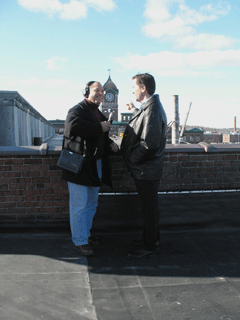
Bruce Gellerman interviews Bob Ansin as they look out at the old clocktower. (Photo: Bruce Gellerman)
GELLERMAN: The old mill is 1600 feet long and contains one and a third million square feet. But except for some warehousing the place has been empty for years. The mill is run down. So is Lawrence. The unemployment rate is twice as high, and incomes, half the state average. The old Wood mill is a metaphor for the city.
ANSIN: When I started this business people would tell me, “What do you want with an obsolete white elephant in a city like Lawrence?” And my response is, the only thing obsolete is thinking the fact that we economically can’t make textiles here eliminates one use out of a million uses for a building such as this.
GELLERMAN: Ansin is turning the white elephant into a huge green energy project; morphing the mothballed Wood Mill into Monarch on the Merrimack. There’ll be 600 luxury condos, a jazz club, a restaurant - café, and retail shops. Around the construction site are signs that read: “Green People Wanted”

When the Wood Mill was built in 1906, it was hailed as 'the eighth wonder of the world.' At a third of a mile long and with almost 30 acres under one roof, it has been described as a horizontal skyscraper. (Photo: Bruce Gellerman)
GELLERMAN: To fulfill that vision and make it commercially viable to heat and cool the enormous mill building all factors pointed in one direction: straight down.
[DRILLING SOUNDS]
GELLERMAN: In the parking lot between the Merrimac River and the old Mill building workers drill into the earth.
BOVENZI: This right now, I believe is the largest, privately funded geothermal project in the United States.
GELLERMAN: Mathew Bovenzi is president of Commonwealth National Drilling, he and his workers are boring the first of 60 wells each 15 hundred feet deep into the granite below.
According to federal officials, a geothermal exchange system- like this one-is the most efficient and environmentally friendly way to heat and cool a building. Matt Bovenzi says it’s the best way on earth because it uses the earth. If you have ever walked into a cool basement on a hot day you know how geothermal exchange works.
BOVENZI: Essentially if you think of the ground as, the thermal mass is so large, it relatively stays at a constant temperature. At about five feet down, down to about 1500 feet you can expect the ground temperature to be 53-54 degrees Fahrenheit. So the idea is that if you take the heat load or the cooling load of the building and pump that into the ground, the ground’s temperature is going to stay constant so you can regulate the temperature of the building just by the temperature of the ground.
GELLERMAN: So what you do is, let’s say in the summer, you have hot water that comes out of the building, and it goes into the ground it comes out much cooler?
BOVENZI: Exactly. Essentially if the building is 80 degrees and you know the ground is 54, over time you just keep pumping the 80 degree temperature into the ground and then you bring the net difference of the cooling effect back into the building which will drop the building’s temperature.
GELLERMAN: And in the winter you reverse the process?
BOVENZI: Exactly
GELLERMAN: Monarch on the Merrimack’s geothermal exchange system is expected to save condo owners about 30 percent on their heating and cooling costs. The only fossil fuels used are to run the pumps and compressors. Bob Ansin says you’d have to plant a forest with 600 acres of trees to derive the same benefit to the environment as the Monarch on the Merrimack project will save in terms of global warming gases.

The ecoluxury lofts at Monarch were designed with sustainable development principles in mind - renewable resources (bamboo countertops, geothermal heating and cooling), reclaimed materials (reclaimed maple floors), and by hiring and purchasing locally, wherever possible.(Photo: Massinnovation)
ANSIN: Which will have trees and have plants and have grasses specially built to hold water as much as possible.
GELLERMAN: That will help prevent sewers on the ground from overflowing into the Merrimack River and keep the building cooler. But Ansin’s project isn’t just about protecting the environment for the future; it’s also about preserving the past. The mill building may be empty today but it’s filled with history.
JAYSANE: The wood mill was, for it’s time a very modern place.
GELLERMAN: Patricia Jaysane is executive director of the Lawrence History Center. She says the city lies at a critical junction in American industrial, cultural and technological history. It’s where the American labor movement was born.
[MUSIC: Bill Martin “The River Turns The Wheel” from ‘The River Turns The Wheel’ (Mill Rat Music – 1997)]
GELLERMAN: By the turn of the 20th century mill owners, who had started as urban idealists, had become cold-hearted industrialists.
Hundreds of thousands of workers came from Ireland and Italy, Eastern Europe and the Middle East to work the mills. Lawrence became known as Immigrant City a place of squalid tenements and horrendous factories.
JAYSANE: With all the mills you had the same kind of conditions. You had the machinery, which was incredibly loud.
[SOUND MILL WORKING]
GELLERMAN: Construction workers converting Wood Mill into Monarch on the Merrimack recently found these old recordings of mill workers and weaving machines.
WOMAN: The machine would start up and it might have a humming noise, hmmmmm. It wasn’t like the weaving room pickapickapicka oh my God.
[SOUND OF SEWING MACHINES]
GELLERMAN: 25 thousand people worked in the mills, most were women, many were children, some as young as seven years old.
JAYSANE: It was very dangerous work. Injury was very, very common as well as illness from the working conditions. The dust would just build up
GELLERMAN: A third of the workers died before they were 25. In the winter of 1912 a new Massachusetts law went into effect cutting the work week from 56 to 54 hours. Mill owners responded by speeding up the looms. The workers - 20 thousand strong - went on strike.
[MUSIC: I’M STICKING WITH THE UNION: Woody Guthrie (Composer) “I’m Sticking With The Union (Instrumental)” performed by unknown artist from ‘Lawrence, Mass. Music Library Archives’ (Source material reel-to-reel 1/4” tape – approx. 1941)]
GELLERMAN: The Lawrence Mill owners struck back with goon squads beating up workers. The National Guard was called in. For three months the workers held fast demanding bread, increased wages, and roses: respect.
[MUSIC: Judy Collins “Bread And Roses” from ‘Forever: The Judy Collins Anthology’ (Elektra/Asylum – 1970)]
GELLERMAN: The Bread and Roses strike was a turning point in the American labor movement and the Wood Mill was at its epicenter. Developer Bob Ansin:
ANSIN: 90 odd years ago had we been in this spot, in this mill, on this floor you would be seeing workers sabotaging their machines, you’d be seeing people from 50 countries, speaking 50 languages, marching along this hall way, convincing their fellow workers to also join the strike, as well they did.
GELLERMAN: In the end the mill owners met the workers’ demands.
[BELLS FROM AYER MILL CLOCK TOWER]
GELLERMAN: But at the end of World War Two textile manufacturers pulled the plug on Lawrence’s mills moving machinery and jobs to the south, then overseas, draining the lifeblood out of the city.
For a while main frame computers were manufactured in Wood mill. Then that technology became obsolete too and companies again left Lawrence. Unemployment soared. In the 1990’s the city became known as the arson capitol of the country. Lawrence was dying.
That’s the situation developer Bob Ansin found when he arrived with his plan to turn historic Wood Mill into Monarch on the Merrimack, mindful of the past but with one eye on the future and the other on the bottom line.
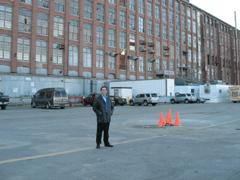
Bob Ansin, president of Massinnovation and developer of Monarch on the Merrimack. (Photo: Bruce Gellerman)
ANSIN: I didn’t become a green developer through being an environmentalist. It’s less risky and more profitable to use green technologies. I see this as smart business.
GELLERMAN: It’s a double green bottom line, part of a growing trend says housing consultant Ed Connelly.
CONNELLY: What I see, is I think the financing side is starting to drive it.
GELLERMAN: Connelly is president of New Ecology. His firm helps developers design and build green affordable housing projects. He says in recent years there’s been a fundamental shift among large financial companies interested in backing geothermal and other renewable energy projects.
CONNELLY: So it’s a very big change. I’ve been doing this for 10-15 years and 15 years ago, if you talked to corporate about this and they looked at you as a crazy tree hugger. And now that’s changing.
GELLERMAN: Connelly says, Monarch on the Merrimack is such a big geothermal project that if it’s successful it’s bound to have a huge economic impact on Lawrence, Massachusetts and serve as a model for other project. Still that’s a big “if”.
CONNELLY: In real estate market, I mean, obviously it’s still very complex. Location, location, location is still the mantra, that people are not going to go out of the way to buy a green building. At least most people won’t, but I think that in an increasingly competitive marketplace, that this is going to be one of the distinguishing characteristics of buildings.
GELLERMAN: That’s what developer Bob Ansin is banking on. His Monarch on the Merrimack project is a 200 million dollar bet that by restoring one old mill building in Lawrence using green technology he can help revitalize a city where hopes and fortunes once soared.
[MUSIC: Bill Martin “The River Turns The Wheel” from ‘The River Turns the Wheel’ (Mill Rat Music – 1997)]
ANSIN: We came to Lawrence with a vision for how to bring a place that was built for one economic reality, how to bring it back for today’s economic reality and do it in a way so that my kids and their kid’s kids will never find themselves in a position to have to say, gee too bad it wasn’t built sustainably.

Monarch on the Merrimac, Lawrence, MA. (Photo: Massinnovation)
For Living on Earth I’m Bruce Gellerman
Related links:
- MassInnovation
- New Ecology Inc.
- Lawrence History Center
- U.S. Department of Energy: Geothermal Technologies Program
[MUSIC Bill Martin “The River Turns The Wheel” from ‘The River Turns the Wheel’ (Mill Rat Music – 1997)]
CURWOOD: Next week on Living on Earth thirty years ago, naturalist George Scahller traveled to Tibet in search of the elusive snow leopard. Now Scahller has returned in search of another iconic animal. This time he has a happier story to tell.
SCAHLLER: In this seemingly barren country, we were surprised by how much wildlife we encountered, and were delighted to count about 8,000 Chiru. It was a hopeful sign for the future.
CURWOOD: George Schaller returns to Tibet next time on Living on Earth.
[KIDS PLAYING TAG IN SNOW]
CURWOOD: We leave you this week with a little playtime in the ice and snow.
As old man winter still tries to hold down the snow-fort in many parts of the country, these youngsters are taking advantage of his waning shivery grip.
[KIDS SCREAMING & LAUGHING]
CURWOOD: Paige Doughty recorded these kids romping in the snowy woods of Belmont, Massachusetts.
CURWOOD: Living on Earth is produced by the World Media Foundation. Our crew includes Ashley Ahearn, Eileen Bolinsky, Bruce Gellerman, Ian Gray, Ingrid Lobet, Emily Taylor, Peter Thomson and Jeff Young - with help from Bobby Bascomb and Kelley Cronin. Our interns are Paige Doughty and Meghan Vigeant. Dennis Foley is our technical director. Alison Lirish Dean composed our themes. You can find us anytime at l-o-e dot org. I’m Steve Curwood. Thanks for listening.
ANNOUNCER: Funding for Living on Earth comes from the National Science Foundation, supporting coverage of emerging science; And Stonyfield Farm Organic yogurt, smoothies and milk. Ten percent of profits are donated to efforts that help protect and restore the earth. Details at Stonyfield dot com.
Support also comes from you our listeners, the Ford Foundation, the Geraldine R. Dodge Foundation Park Foundation, and the Saunders Hotel Group of Boston's Lennox and Copley Square Hotels. Serving you and the environment while helping preserve the past and protect the future, 800-225-7-6-7-6.
Living on Earth wants to hear from you!
Living on Earth
62 Calef Highway, Suite 212
Lee, NH 03861
Telephone: 617-287-4121
E-mail: comments@loe.org
Newsletter [Click here]
Donate to Living on Earth!
Living on Earth is an independent media program and relies entirely on contributions from listeners and institutions supporting public service. Please donate now to preserve an independent environmental voice.
NewsletterLiving on Earth offers a weekly delivery of the show's rundown to your mailbox. Sign up for our newsletter today!
 Sailors For The Sea: Be the change you want to sea.
Sailors For The Sea: Be the change you want to sea.
 The Grantham Foundation for the Protection of the Environment: Committed to protecting and improving the health of the global environment.
The Grantham Foundation for the Protection of the Environment: Committed to protecting and improving the health of the global environment.
 Contribute to Living on Earth and receive, as our gift to you, an archival print of one of Mark Seth Lender's extraordinary wildlife photographs. Follow the link to see Mark's current collection of photographs.
Contribute to Living on Earth and receive, as our gift to you, an archival print of one of Mark Seth Lender's extraordinary wildlife photographs. Follow the link to see Mark's current collection of photographs.
 Buy a signed copy of Mark Seth Lender's book Smeagull the Seagull & support Living on Earth
Buy a signed copy of Mark Seth Lender's book Smeagull the Seagull & support Living on Earth

